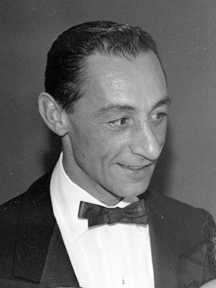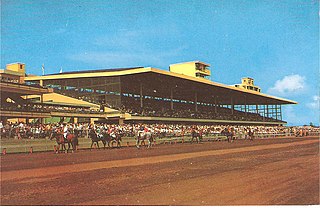Related Research Articles

George Edward Arcaro was an American Thoroughbred horse racing Hall of Fame jockey who won more American classic races than any other jockey in history and is the only rider to have won the U.S. Triple Crown twice. He is widely regarded as one of the greatest jockeys in the history of American Thoroughbred horse racing. Arcaro was born in Cincinnati, Ohio, the son of an impoverished taxi driver. His parents, Pasquale and Josephine, were Italian immigrants and his father held a number of jobs, including taxi driver and operator of an illegal liquor enterprise during Prohibition. Arcaro was born prematurely, and weighed just three pounds at birth; because of this, he was smaller than his classmates and was rejected when he tried out for a spot on a baseball team. His full height would reach just five-foot, two inches. Eventually nicknamed "Banana Nose" by his confreres, Arcaro won his first race in 1932 at the Agua Caliente racetrack in Tijuana, Mexico; he was 16 years old. In 1934, the inaugural year of Narragansett Park, Arcaro was a comparative unknown who rode many of his early career races at 'Gansett.
The Jockey Club Gold Cup, established in 1919, is a thoroughbred flat race open to horses of either gender three-years-old and up. It has traditionally been the main event of the fall meeting at Belmont Park, just as the Belmont Stakes is of the spring meeting and the Travers Stakes is of the summer meeting at Saratoga. The past winners of the Gold Cup are a veritable who's who of award-winning Hall of Fame horses, including Easy Goer, Man o' War, Cigar, Skip Away, Curlin, Slew o' Gold, John Henry, Affirmed, Forego, Shuvee, Damascus, Buckpasser, Kelso, Sword Dancer, Nashua, Citation, Whirlaway and War Admiral. Despite the current $1,250,000 purse and Grade 1 status, the stature of the race has suffered somewhat in recent years thanks to the emergence of the Breeders' Cup Classic held not long afterward, as well as a change in distance to 1+1⁄4 miles in 1990, reducing its distinctiveness.
The Acorn Stakes is an American Grade I race at Belmont Park in Elmont, New York for three-year-old Thoroughbred fillies. It is raced on dirt over a distance of one mile and a sixteenth with a current purse of $500,000. It is the first leg of the US Triple Tiara and is followed by the Coaching Club American Oaks then the Alabama Stakes. The filly must win all three races to win the Triple Tiara, as well as the third leg of the "National" Triple Tiara.
The Beldame Stakes is an American Thoroughbred horse race for fillies and mares three-years-old and up. Inaugurated in 1939, it was run as a handicap prior to 1960. The race is held annually near the beginning of October at Belmont Park and currently offers a purse of $400,000.
The Alabama Stakes is an American Thoroughbred horse race open to three-year-old fillies. Inaugurated in 1872, the Grade I race is run over a distance of one and one-quarter miles on the dirt track at Saratoga Race Course. Held in mid August, it currently offers a purse of $600,000. In 2010 it became the third leg of the American Triple Tiara of Thoroughbred Racing, after the Acorn Stakes and Coaching Club American Oaks.
The Personal Ensign Stakes is an American Grade I Thoroughbred horse race held annually during the third week of August at Saratoga Race Course in Saratoga Springs, New York. Open to fillies and Mares age three and older, it is contested at a distance of one and one-eighth miles on dirt.
The Test Stakes is an American Thoroughbred horse race open to three-year-old fillies and run each summer at the Saratoga Race Course in Saratoga Springs, New York. It is contested at a distance of seven furlongs on the dirt and is an influential race in shaping the Breeders' Cup Filly & Mare Sprint. A Grade I event, it carries a purse of $500,000.
The Delaware Oaks Stakes is an American Thoroughbred horse race run annually in mid July at Delaware Park Racetrack in Stanton near Wilmington, Delaware.
Wheatley Stable was the nom de course for the thoroughbred horse racing partnership formed by Gladys Mills Phipps and her brother, Ogden Livingston Mills. The horses were raised at Claiborne Farm near Paris, Kentucky.
The Miss Woodford Stakes is an American Thoroughbred horse race usually run each year in August at Monmouth Park Racetrack in Oceanport, New Jersey open to three-year-old fillies. An ungraded stakes currently offering a current purse of $75,000, it is a sprint race contested over a distance of six furlongs on the dirt.

Narragansett Park was an American race track for Thoroughbred horse racing in Pawtucket, Rhode Island.
Faireno was an American Champion Thoroughbred racehorse best known for winning the Belmont Stakes in 1932.
The Narragansett Special was an American Thoroughbred horse race run annually at Narragansett Park in Pawtucket, Rhode Island. At the time of its inaugural running in 1934, the Narragansett Special offered a purse of $32,500 added money making it the biggest race run at the track. Only Suffolk Downs' Massachusetts Handicap, which ran the next summer, had a bigger purse in New England. Both rich contests drew the best talent that the nation had to offer.
Vigil was an American Thoroughbred racehorse best known for winning the 1923 Preakness Stakes in a performance the Los Angeles Times called "the most brilliant victory in the history of the Preakness."
The Roger Williams Handicap was an American Thoroughbred horse race run annually at Narragansett Park in Pawtucket, Rhode Island and named for the founder of the State of Rhode Island. The track sat on land just west of the Ten Mile River which Roger Williams traveled down after being banished from Massachusetts in 1636. The track management had purchased the land from the former What Cheer Airport in 1934. Curiously, “What cheer, Netop” were the words called out by the Narragansett Indians when Roger Williams first set foot in the place he was to call "Providence". Only the word Netop − meaning "friend" − is Indian and the phrase was meant as a greeting.
The Rhode Island Handicap was an American Thoroughbred horse race run annually at Narragansett Park in Pawtucket, Rhode Island from 1934 to 1948. The race was designed to be the closing day feature of the tracks very first meet. The handicap event was given a $10,000 purse, the largest of the meet. Older handicap horses were the racing stars of the day and the Rhode Island Handicap was to be the track's signature race.
Arnold Kirkland was an American Thoroughbred horse racing jockey. He was from Petersburg, Virginia and became one of the nation's top jockeys in the 1940s and 1950s.
The Huron Handicap was an American Thoroughbred horse race run between 1901 and 1940 at Saratoga Race Course in Saratoga Springs, New York. Raced on dirt, it was run at a distance of 1 3/16 miles with the exception of 1914 when the distance was set at 1 1/4 miles.
The New England Oaks was an American Thoroughbred horse race held annually from 1936 thru 1944 at Narragansett Park in Pawtucket, Rhode Island. Run on dirt over a distance of a mile and one-sixteenth, like all "Oaks" races for Thoroughbreds, it was open to three-year-old fillies only.
Lord Putnam was an American Thoroughbred racehorse that, as a two-year-old, broke the track record at two different racetracks in the first three starts of his racing career.
References
- ↑ "A Racing Life" by Allen Woodville" (1969)
- ↑ "Official Racing Charts: Narragansett Park". Daily Racing Form at University of Kentucky Archives. 1946-05-27. Retrieved 2020-07-09.
- ↑ The Pawtucket Times
- ↑ "Hyperion" by Clive Graham (1967)
- ↑ "National Museum of Racing and Hall of Fame".
- ↑ The History of Thoroughbred Racing in America by William H. P. Robertson (1964)
- ↑ "National Museum of Racing and Hall of Fame".
- ↑ "Jockey Dies After Spill In Workout". Sarasota Journal. 1961-07-11. Retrieved 2020-07-09.
- ↑ "Bureaucracy Triumphs in $28,400 Providence Stakes at Narragansett Park". New York Times, Section Sports, page 149. 1957-07-14. Retrieved 2020-07-08.
- ↑ "A Racing Life" by Allen Woodville (1969)